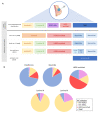Predictive Biomarkers of Response to Neoadjuvant Chemotherapy in Breast Cancer: Current and Future Perspectives for Precision Medicine
- PMID: 36010869
- PMCID: PMC9405974
- DOI: 10.3390/cancers14163876
Predictive Biomarkers of Response to Neoadjuvant Chemotherapy in Breast Cancer: Current and Future Perspectives for Precision Medicine
Abstract
Pathological complete response (pCR) after neoadjuvant chemotherapy in patients with early breast cancer is correlated with better survival. Meanwhile, an expanding arsenal of post-neoadjuvant treatment strategies have proven beneficial in the absence of pCR, leading to an increased use of neoadjuvant systemic therapy in patients with early breast cancer and the search for predictive biomarkers of response. The better prediction of response to neoadjuvant chemotherapy could enable the escalation or de-escalation of neoadjuvant treatment strategies, with the ultimate goal of improving the clinical management of early breast cancer. Clinico-pathological prognostic factors are currently used to estimate the potential benefit of neoadjuvant systemic treatment but are not accurate enough to allow for personalized response prediction. Other factors have recently been proposed but are not yet implementable in daily clinical practice or remain of limited utility due to the intertumoral heterogeneity of breast cancer. In this review, we describe the current knowledge about predictive factors for response to neoadjuvant chemotherapy in breast cancer patients and highlight the future perspectives that could lead to the better prediction of response, focusing on the current biomarkers used for clinical decision making and the different gene signatures that have recently been proposed for patient stratification and the prediction of response to therapies. We also discuss the intratumoral phenotypic heterogeneity in breast cancers as well as the emerging techniques and relevant pre-clinical models that could integrate this biological factor currently limiting the reliable prediction of response to neoadjuvant systemic therapy.
Keywords: biomarkers; breast cancer; intratumoral heterogeneity; neoadjuvant chemotherapy; predictive factors.
Conflict of interest statement
The authors declare no conflict of interest.
Figures



References
-
- Cardoso F., Kyriakides S., Ohno S., Penault-Llorca F., Poortmans P., Rubio I.T., Zackrisson S., Senkus E. Early breast cancer: ESMO Clinical Practice Guidelines for diagnosis, treatment and follow-up†. Ann. Oncol. Off. J. Eur. Soc. Med. Oncol. 2019;30:1194–1220. doi: 10.1093/annonc/mdz173. - DOI - PubMed
-
- Cardoso F., Paluch-Shimon S., Senkus E., Curigliano G., Aapro M.S., André F., Barrios C.H., Bergh J., Bhattacharyya G.S., Biganzoli L., et al. 5th ESO-ESMO international consensus guidelines for advanced breast cancer (ABC 5) Ann. Oncol. Off. J. Eur. Soc. Med. Oncol. 2020;31:1623–1649. doi: 10.1016/j.annonc.2020.09.010. - DOI - PMC - PubMed
Publication types
LinkOut - more resources
Full Text Sources

